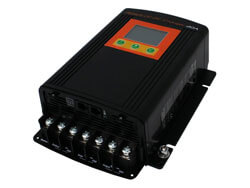The isolator is there so that running the house loads in the RV can't drain the starter batteries stranding you in the middle of nowhere. What the isolate will not do is protect your LiFePo4 house battery from being overcharged by the alternator. Nor will it prevent your house battery from cooking the alternator if the house batteries are at too low of a SOC when you try to charge them from the alternator.
A DC-DC charger (like an Victron Orion TR) will provide both charge management for your new lithium batteries and will also protect against draining the starter battery with house loads. The Orion will not however change your starter battery from the house battery.
Far as I can see the DC-DC converter plus a set of jumper cables (in the event you need to jump start the engine from the house battery) will do everything you need. I would replace the isolator with the DC-DC converter since otherwise you will get unnecessary power drop in the isolator.
An alternative if you will have solar power is to use a Renogy DDC50. The provides both alternator and solar charging of the house battery and will also divert solar power to charge the starter battery if needed. The downside to the DDC50 is it is 12V only (no 24V house battery), is not really configurable and has very a low solar panel input voltage limit (25V).
Make sure your service battery has all the juice it needs with Renogy's DCC50S DC-DC MPPT On-Board Battery Charger. 10% off: Renogy10off. Free shipping

www.renogy.com
There is an alternative to the Renogy with a higher solar input voltage limit, but the name escapes me. Starts with a K.

www.renogy.com



